Hasegawa 1/48 FW-190A-9
|
KIT #: |
07312 |
|
PRICE: |
$ |
|
DECALS: |
Two options |
|
REVIEWER: |
Tom Cleaver |
|
NOTES: |
|
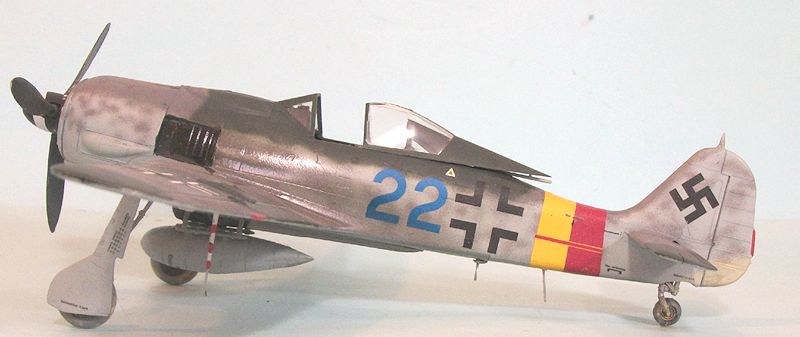
By the summer of 1944, the Focke-Wulf Fw-190A-8 was the
standard version of the Wurger in service.
As compared with the lightweight Fw-190A-6 - the best
dog-fighter of the series - the A-8 had become sluggish as more weight was added
on with additional armor and heavier weapons with which to attack the American
B-17 and B-24 bombers.
With the decline in pilot quality after the horrendous
losses of experienced fighter pilots during the Battle of Germany from January
through April 1944, the Wurger Geschwadern were increasingly seen by American
pilots in their P-51B and new P-51D fighters as increasingly-easy targets.
A performance upgrade was needed if the radial-powered
Fw-190 was to remain competitive.
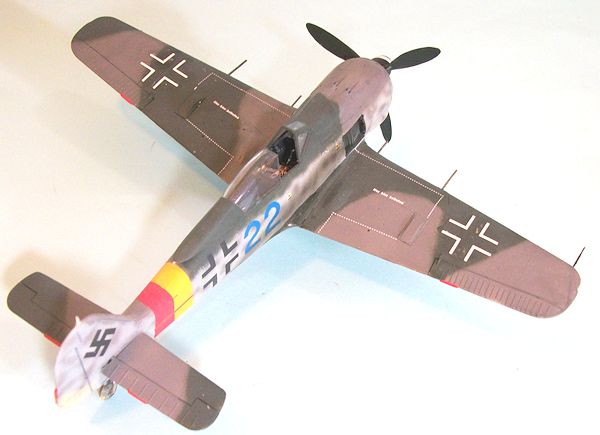 Focke-Wulf responded with the Fw-190A-9.
Originally it was planned to power the new sub-type with
the BMW 801F, providing 2,400 h.p., a significant increase over the 1,900 hp of
the BMW-801D-2 that powered the Fw-190A-8.
Unfortunately, BMW was unable to produce this engine in
time, so the BMW-801S was substituted.
This provided 2,000 h.p. without having to resort to the
MW 50 methanol-water additive, which only gave the BMW-801D-2 engine a similar
power rating for a few minutes.
These BMW-801S engines were delivered as a power unit -
the BMW 801 TS - with a more efficient radiator and larger armored oil tank
mounted in front of the engine, which increased the cowling length by 30 mm. The
12‑blade cooling fan was initially changed to a 14‑blade fan, but it consumed
more power to operate and did not really improve cooling; thus BMW reverted to
the 12‑blade fan. The A‑9 cowling was slightly longer than that of the A‑8 (30
mm) due to a larger annular radiator within the forward cowl for the oil system.
Also, the thickness of the armor on the oil tank increased from 6 to 10 mm,
which gave better protection for the pilot when attacking the bomber stream. The
new powerplant utilized the VDM 9‑112176A wooden paddle-blade propeller, which
was the preferred option; however, many A‑9s were fitted with the standard VDM
9‑12067A metal propeller and some had a VDM 9‑12153A metal propeller with
external, bolt on balance weights.
The airframe was also lightened as much as possible,
while maintaining the heavy armament of the earlier sub-type.
Focke-Wulf responded with the Fw-190A-9.
Originally it was planned to power the new sub-type with
the BMW 801F, providing 2,400 h.p., a significant increase over the 1,900 hp of
the BMW-801D-2 that powered the Fw-190A-8.
Unfortunately, BMW was unable to produce this engine in
time, so the BMW-801S was substituted.
This provided 2,000 h.p. without having to resort to the
MW 50 methanol-water additive, which only gave the BMW-801D-2 engine a similar
power rating for a few minutes.
These BMW-801S engines were delivered as a power unit -
the BMW 801 TS - with a more efficient radiator and larger armored oil tank
mounted in front of the engine, which increased the cowling length by 30 mm. The
12‑blade cooling fan was initially changed to a 14‑blade fan, but it consumed
more power to operate and did not really improve cooling; thus BMW reverted to
the 12‑blade fan. The A‑9 cowling was slightly longer than that of the A‑8 (30
mm) due to a larger annular radiator within the forward cowl for the oil system.
Also, the thickness of the armor on the oil tank increased from 6 to 10 mm,
which gave better protection for the pilot when attacking the bomber stream. The
new powerplant utilized the VDM 9‑112176A wooden paddle-blade propeller, which
was the preferred option; however, many A‑9s were fitted with the standard VDM
9‑12067A metal propeller and some had a VDM 9‑12153A metal propeller with
external, bolt on balance weights.
The airframe was also lightened as much as possible,
while maintaining the heavy armament of the earlier sub-type.
The prototype of the Fw-190A-9 flew in August 1944.
Top speed was the highest of all the BMW‑powered
versions, reaching 416 mph at altitude.
Cruise, takeoff, and climb were also improved by the
extra power of the BMW 801S engine, with climb to 6,000 meters in 7.5 minutes,
and improved initial acceleration at low altitude.
With these changes, the radial-engined Fw-190 was
finally able to meet the latest P-51D on even terms.
The main version produced was the Fw0190A-9/R11, fitted
with all‑weather flying equipment including the PKS12 and K‑23 systems for
steering and autopilot; the FuG 125 radio system, known as Hermine was fitted to
the aircraft, as well as a heated windscreen.
The Fw-190A-9 was also fitted with the blown “Galland”
hood which was also used on the Fw-190F-8 and F-9 ground-attack f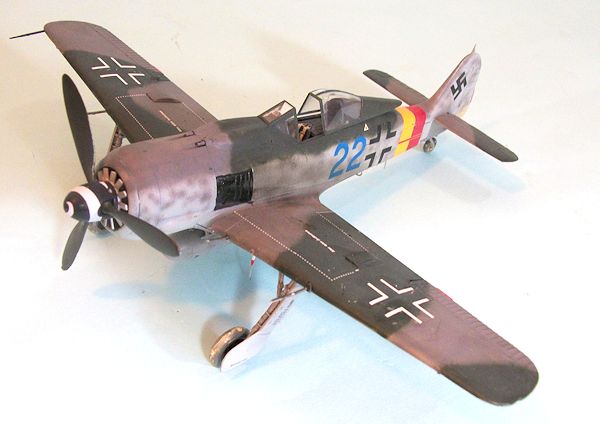 ighter.
Some A-9s also received a new wooden vertical fin
similar to that used on the Ta-152.
ighter.
Some A-9s also received a new wooden vertical fin
similar to that used on the Ta-152.
Due to a need to keep production lines flowing, the
Fw-190A-9 was introduced to production alongside the earlier A-8, and both
sub-types were produced through to the end of the war.
Monthly output of the A-9 depended on the limited
deliveries of BMW 801 TS engines.
All of these aircraft were delivered to the
Geschwadern engaged in Defense of the Reich.
With declining delivery of fuel in the final months of
the war, the aircraft saw less and less service.
Most of the 910 Fw-190A-9s were produced by the
Focke‑Wulf factory at Cottbus, with the remaineder produced by Focke‑Wulf at
Aslau, Mimetall at Erfurt, and Norddeutsche Dornier at Wismar. All of these
aircraft were delivered to the Geschwadern
engaged in Defense of the Reich.
With declining delivery of fuel in the final months of
the war, the aircraft saw less and less service.
Hasegawa, Tamiya,
Eduard produce 1/48 Fw-190 kits, with the original Trimaster/Dragon kits also
available in limited numbers.
The Hasegawa kits, which are based on the Trimaster
originals, with modifications to decrease the fiddly factor and increase
buildability, offer the greatest accuracy combined with the easiest
construction.
This Fw-190A-9 is one of Hasegawa's limited release kits, and the
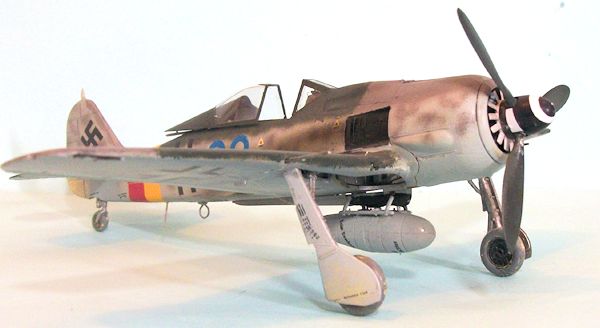 differences
unique to the A‑9 are addressed well, though it appears that the cowling is the
same size as that in the A-8 kit, which means it is not as long as that used by
the A-9.
Given that 30mm translates to a bit less than 1mm in 1/48, no one is
particularly likely to notice this fact.
Hasegawa includes a white metal 14 blade fan as well as
the original 12 blade fan in plastic, which means a modeler who has research on
the specific aircraft he is doing can produce the model with either.
Additionally, a white metal replacement prop is included
representing the wider chord wooden prop used on some aircraft; the earlier
narrower chord metal props is included on the sprues. The engine is well
detailed, but quite simple in construction, though there is virtually nothing to
be seen once the fan is in position.
differences
unique to the A‑9 are addressed well, though it appears that the cowling is the
same size as that in the A-8 kit, which means it is not as long as that used by
the A-9.
Given that 30mm translates to a bit less than 1mm in 1/48, no one is
particularly likely to notice this fact.
Hasegawa includes a white metal 14 blade fan as well as
the original 12 blade fan in plastic, which means a modeler who has research on
the specific aircraft he is doing can produce the model with either.
Additionally, a white metal replacement prop is included
representing the wider chord wooden prop used on some aircraft; the earlier
narrower chord metal props is included on the sprues. The engine is well
detailed, but quite simple in construction, though there is virtually nothing to
be seen once the fan is in position.
Decals are included for a staff aircraft of I/JG 4
(Sturm), and for Red 22 of 6./JG301 based at Stendal April 1945; since it is
unclear that the numbers were actually red, there is an alternative set of
numbers in blue.
Full stenciling is included, and this sheet is new enough that
the whites on it are really white and not the ivory color previously associated
with Hasegawa decals.
For those who wish to use aftermarket decals, there are
a number of sheets that have been produced, which I am sure most Wurger fans
have in their collections.
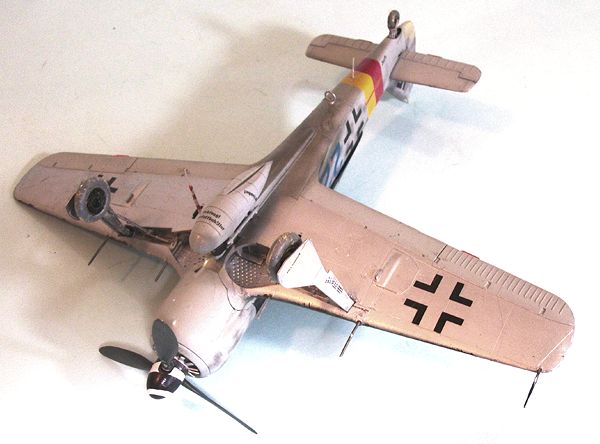 Construction of the kit is as easy as the other Hasegawa
Fw-190A kits, and I accomplished my assembly of the airframe without having to
use any filler on seams or joints.
I only added a set of Eduard seat belts to the cockpit,
since the seat is really the only part of an Fw-190 cockpit that can really be
seen.
Construction of the kit is as easy as the other Hasegawa
Fw-190A kits, and I accomplished my assembly of the airframe without having to
use any filler on seams or joints.
I only added a set of Eduard seat belts to the cockpit,
since the seat is really the only part of an Fw-190 cockpit that can really be
seen.
The only fiddly part of the assembly is getting the
four-part cowling around the engine, once the engine is glued to the mount.
To maximize the difference between this model and others
in the collection, I utilized the white metal 14-blade fan and the white metal
paddle prop; whether that fit was exactly right for the airplane depicted I do
not really know.
There are numerous photos of late war Fw-190s that show
the lower wing and wheel wells left in natural metal, which I decided to do with
this model.
I painted the main lower wing and wheel well, and the gear legs
and interior of the gear doors with Auto Air Aluminum, then sealed that with
Model Master Metalizer Sealer.
I painted the model with Xtracrylix RLM76 for the lower
surfaces, with the upper surfaces
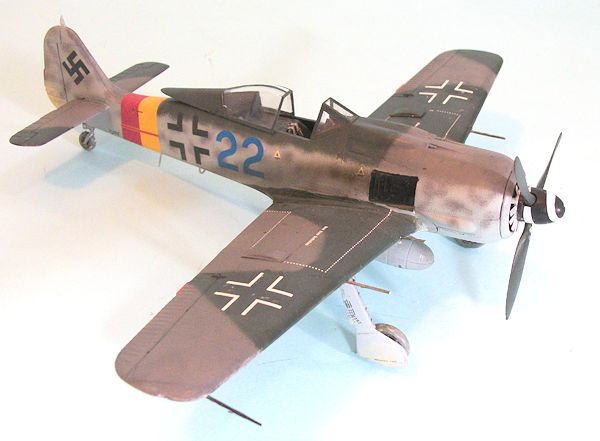 in RLM75
Grauviolett and RLM83
Dunkelgrun.
The kit painting instructions for the JG301 airplane
would have you add a yellow lower cowling, but since the prop spinner has the
white spiral that was applied after July 1944, this means that there was no
yellow marking since they were deleted from aircraft at that time.
in RLM75
Grauviolett and RLM83
Dunkelgrun.
The kit painting instructions for the JG301 airplane
would have you add a yellow lower cowling, but since the prop spinner has the
white spiral that was applied after July 1944, this means that there was no
yellow marking since they were deleted from aircraft at that time.
I used the kit
decals for the individual markings.
Since I had spilled some solvent on the decal sheet and
harmed the red “22" decals I used the blue “22,” which in a black and white
photo would be tonally similar to red numbers, which is probably why Hasegawa
included these.
This actually looks better to my mind so far as additional color
on the model is concerned.
I used the decals for the red and yellow JG 301 Defense
of the Reich marking.
I used national markings and stencils from a Lifelike
Decals sheet for the rest of the markings.
I applied a coat
of Xtracrylix Flat Varnish, then attached the landing gear and prop and unmasked
the canopy, which I posed open.
I figured this airplane likely didn't see enough action
to get badly “dinged,” so I only gave the model exhaust stains using Tamiya
“Smoke.”
I did “muddy” the wheels, since the winter and spring of 1944/45 was a
period of heavy snow and rain, and photographs show the dirt strips the
Luftwaffe was reduced to using were pretty muddy.
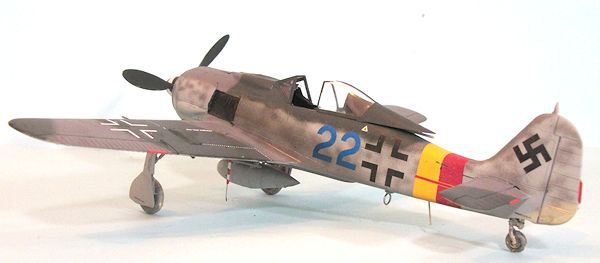 The Hasegawa FW190A series are regarded as the most accurate kits in 1/48 and
the particulars of the Fw-190A‑9 are nicely captured with the additional parts.
The kit is, however, more expensive than the Eduard competition, particularly
when you consider the Eduard Profipack has extras such as photoetch and canopy
masks included.
But the Hasegawa kit is still better value given that it is much
more “buildable,” unlike the fiddly Eduard kits which I have finally given up
on.
The design of the Hasegawa kit makes for real ease of construction and
the quality of molding is superb; it's just about impossible to get the
alignment of the gear wrong. The blown cockpit of the A‑9 provides a different
look when the model is sitting next to your other Wurgers.
The Hasegawa FW190A series are regarded as the most accurate kits in 1/48 and
the particulars of the Fw-190A‑9 are nicely captured with the additional parts.
The kit is, however, more expensive than the Eduard competition, particularly
when you consider the Eduard Profipack has extras such as photoetch and canopy
masks included.
But the Hasegawa kit is still better value given that it is much
more “buildable,” unlike the fiddly Eduard kits which I have finally given up
on.
The design of the Hasegawa kit makes for real ease of construction and
the quality of molding is superb; it's just about impossible to get the
alignment of the gear wrong. The blown cockpit of the A‑9 provides a different
look when the model is sitting next to your other Wurgers.
Tom Cleaver
June 2013
Review
Kit courtesy of the modeler's estate sale and its bargains.
If you would like your product reviewed fairly and fairly quickly, please
contact
the editor or see other details in the
Note to
Contributors.
Back to the Main Page
Back to the Review
Index Page



 ighter.
Some A-9s also received a new wooden vertical fin
similar to that used on the Ta-152.
ighter.
Some A-9s also received a new wooden vertical fin
similar to that used on the Ta-152. differences
unique to the A‑9 are addressed well, though it appears that the cowling is the
same size as that in the A-8 kit, which means it is not as long as that used by
the A-9.
Given that 30mm translates to a bit less than 1mm in 1/48, no one is
particularly likely to notice this fact.
Hasegawa includes a white metal 14 blade fan as well as
the original 12 blade fan in plastic, which means a modeler who has research on
the specific aircraft he is doing can produce the model with either.
Additionally, a white metal replacement prop is included
representing the wider chord wooden prop used on some aircraft; the earlier
narrower chord metal props is included on the sprues. The engine is well
detailed, but quite simple in construction, though there is virtually nothing to
be seen once the fan is in position.
differences
unique to the A‑9 are addressed well, though it appears that the cowling is the
same size as that in the A-8 kit, which means it is not as long as that used by
the A-9.
Given that 30mm translates to a bit less than 1mm in 1/48, no one is
particularly likely to notice this fact.
Hasegawa includes a white metal 14 blade fan as well as
the original 12 blade fan in plastic, which means a modeler who has research on
the specific aircraft he is doing can produce the model with either.
Additionally, a white metal replacement prop is included
representing the wider chord wooden prop used on some aircraft; the earlier
narrower chord metal props is included on the sprues. The engine is well
detailed, but quite simple in construction, though there is virtually nothing to
be seen once the fan is in position.
 in RLM75
Grauviolett and RLM83
Dunkelgrun.
The kit painting instructions for the JG301 airplane
would have you add a yellow lower cowling, but since the prop spinner has the
white spiral that was applied after July 1944, this means that there was no
yellow marking since they were deleted from aircraft at that time.
in RLM75
Grauviolett and RLM83
Dunkelgrun.
The kit painting instructions for the JG301 airplane
would have you add a yellow lower cowling, but since the prop spinner has the
white spiral that was applied after July 1944, this means that there was no
yellow marking since they were deleted from aircraft at that time. The Hasegawa FW190A series are regarded as the most accurate kits in 1/48 and
the particulars of the Fw-190A‑9 are nicely captured with the additional parts.
The kit is, however, more expensive than the Eduard competition, particularly
when you consider the Eduard Profipack has extras such as photoetch and canopy
masks included.
But the Hasegawa kit is still better value given that it is much
more “buildable,” unlike the fiddly Eduard kits which I have finally given up
on.
The design of the Hasegawa kit makes for real ease of construction and
the quality of molding is superb; it's just about impossible to get the
alignment of the gear wrong. The blown cockpit of the A‑9 provides a different
look when the model is sitting next to your other Wurgers.
The Hasegawa FW190A series are regarded as the most accurate kits in 1/48 and
the particulars of the Fw-190A‑9 are nicely captured with the additional parts.
The kit is, however, more expensive than the Eduard competition, particularly
when you consider the Eduard Profipack has extras such as photoetch and canopy
masks included.
But the Hasegawa kit is still better value given that it is much
more “buildable,” unlike the fiddly Eduard kits which I have finally given up
on.
The design of the Hasegawa kit makes for real ease of construction and
the quality of molding is superb; it's just about impossible to get the
alignment of the gear wrong. The blown cockpit of the A‑9 provides a different
look when the model is sitting next to your other Wurgers.